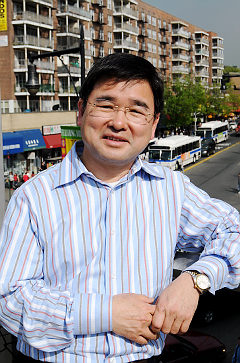
You wouldn't know it from opening the newspaper or turning on the television, but yesterday's City Council hearing on pedestrian plazas actually showed how widespread support for the plazas are. Only two council members appeared to be at all opposed to the plaza program -- though of course those two have dominated the headlines -- while the rest were busy figuring out how to get a plaza in their district. It's no wonder why: the community members and business leaders who spoke at the hearing were nearly unanimous in their support for the plaza program, testifying to its success in creating high-quality public space in neighborhoods that badly need it and helping business along the way.
Perhaps no one, even at DOT, was as excited about plazas as Flushing rep Peter Koo. "I want you to do more plazas in other boroughs," said Koo before offering DOT a litany of suggestions for new kinds of plazas. He suggested plazas dedicated to specialty markets -- one just for electronics vendors, say, and one just for clothes merchants -- and suggested late-night plazas along the model of Taiwan's famous night markets.
Perhaps most ambitiously, Koo suggested that one plaza be dedicated for every nationality of immigrant in the city, 148 in total. It could be a tourism draw, he said: "Visit New York, see the whole world, because we have these 148 different plazas."
Other reps asked DOT how to improve the chances for plaza applicants in their neighborhood. Jackson Heights' Daniel Dromm, who made a point of showing up even though he doesn't serve on the transportation committee, asked DOT for examples of model programming for the plaza space and for an explanation of what standards sponsoring community organizations need to meet. "I have a community that is very much in favor of having plazas in our district," he explained. Brad Lander, too, wanted guidance for his plaza-requesting constituents.
Deborah Rose hoped that a waterfront site in her North Shore district -- she seemed to have a couple in mind -- would become the first pedestrian plaza on Staten Island. Clinton Hill's Letitia James interrupted DOT's testimony with a few "yays" and an "amen" when they discussed the Myrtle Avenue plaza under development in her district. David Greenfield, representing Midwood, concluded that "overall, it seems like a good program," while the Upper West Side's Gale Brewer hoped her district could have the plazas that Eric Ulrich didn't want.
The widespread enthusiasm for the plazas should come as no surprise. The facts on the ground show they're working, as the community and business leaders who testified at the hearing attested.
Dan Biederman, the head of the 34th Street Partnership and the Chelsea Improvement Company, called the plazas in his districts "hugely successful." If the businesses he represents were suffering, he said, he'd know. "I'm not hearing complaining anymore," he reported. Traffic flow and loading work fine, he said, while the pedestrians who actually shop are far safer. Concluded Biederman, "This is the best team we've seen at DOT in the 30 years I've worked in the public sector."
But plazas aren't just for the heart of Manhattan. Daniel Murphy, the head of Brownsville's Pitkin Avenue BID, recalled "our great happiness" when DOT approved plans for a plaza at the Zion Triangle. Now he walks down the street and hears excitement about the project from neighbors who walk by. "Their interest is not simply passive but active and positive," he said.
Alexandria Sica of the Dumbo Improvement District explained how much the two plazas in her neighborhood have done for business and for community. The arch under the Manhattan Bridge, which used to be used for DOT storage, has become a "place for a casual lunch meeting, neighborhood stoop sales, public art and exciting community events," she said. Next to the Pearl Street triangle, said Sica, three new businesses have opened despite a rough economic climate.
Other community leaders testified about how much a plaza could do in their area. "Corona is the most overcrowded school district in the entire city," said Prerana Reddy, the director of public events at the Queens Museum of Art. "We need a place for young people and families to enjoy public spaces." Reddy talked about how Corona Plaza, which she said was mostly a parking lot right now, is already used for a greenmarket and diabetes screening. With real high-quality public space, Corona Plaza could do so much more for Corona residents.
Statements of support for the plaza program also came from residents of the South Bronx, Jackson Heights, the West Village, and Hell's Kitchen, as well as advocacy organizations like Transportation Alternatives, the Tri-State Transportation Campaign, and Project for Public Spaces.
Only two people spoke in opposition: a representative from who claimed to worry about the environmental impact of the plazas and Corey Bearak, the anti-congestion pricing activist, who argued that any removal of street space from motor vehicles should require environmental review. An advocate for the blind also expressed concern that the DOT's temporary plazas do not include tactile safety features so the vision-impaired know where pedestrian space begins and ends.





